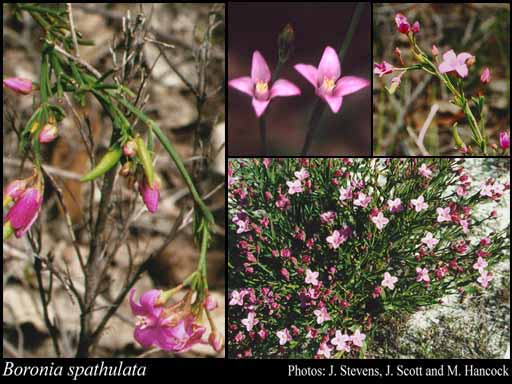- Reference
- Sketch Veg.Swan R. 17 (1839)
- Conservation Code
- Not threatened
- Naturalised Status
- Native to Western Australia
- Name Status
- Current
Erect, slender shrub, 0.15-1 m high. Fl. pink-red, Jan to Dec. Sandy soils. Dunes, damp or wet places, flats.

Scientific Description
Shrub, spines absent; branchlets smooth, without distinct raised glands, +/- cylindrical in cross-section, glabrous. Leaves opposite, simple, 5-30 mm long, 1-12 mm wide, flat, the margins flat or revolute, smooth, without distinct raised glands, glabrous; stipular excrescences absent. Flowers in terminal, loose clusters (cymes or panicles); pedicels 8-10 mm long; calyx present, 3-7 mm long, verrucose (warty), glabrous; corolla red or pink, petals four, 7-12 mm long, imbricate (overlapping), free, glabrous; stamens twice as many as petals, 2-5 mm long, smooth, ciliate (with a marginal fringe of hairs); anthers 1-1.2 mm long, without an appendage. Flowers in January, February, March, April, May, June, July, August, September, October, November and December. Occurs in the South-West Botanical Province, in the Jarrah Forest, Mallee, Warren and Swan Coastal Plain IBRA region(s).
Distribution
- IBRA Regions
- Esperance Plains, Jarrah Forest, Mallee, Swan Coastal Plain, Warren.
- IBRA Subregions
- Eastern Mallee, Fitzgerald, Northern Jarrah Forest, Perth, Recherche, Southern Jarrah Forest, Warren, Western Mallee.
- IMCRA Regions
- Leeuwin-Naturaliste, WA South Coast.
- Local Government Areas (LGAs)
- Albany, Augusta Margaret River, Beverley, Boyup Brook, Bridgetown-Greenbushes, Broomehill-Tambellup, Busselton, Collie, Cranbrook, Denmark, Esperance, Gnowangerup, Jerramungup, Kent, Kojonup, Lake Grace, Manjimup, Mundaring, Murray, Nannup, Plantagenet, Ravensthorpe, Wandering, West Arthur, Williams, Woodanilling.